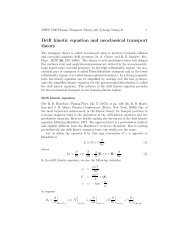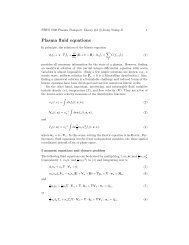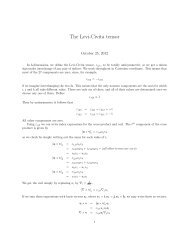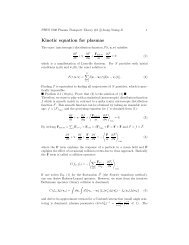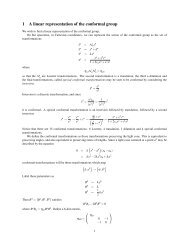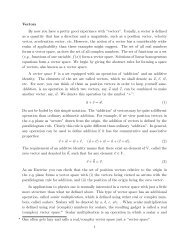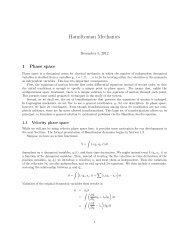Wheeler, Mechanics
Wheeler, Mechanics
Wheeler, Mechanics
You also want an ePaper? Increase the reach of your titles
YUMPU automatically turns print PDFs into web optimized ePapers that Google loves.
This form of the Pythagorean theorem allows us to compute the length of an arbitrary curve by adding up<br />
the lengths of infinitesimal bits of the curve.<br />
Consider a curve, C (λ) with ϕ ◦ C (λ) = x i (λ) . In going from λ to λ + dλ, the change in coordinates is<br />
so the length of the curve from λ = 0 to λ = 1 is<br />
l 01 =<br />
=<br />
dx i = dx i<br />
dλ dλ<br />
∫ 1<br />
0<br />
∫ 1<br />
0<br />
ds (λ)<br />
√<br />
g ij<br />
dx i<br />
dλ<br />
dx j<br />
dλ dλ<br />
which is an ordinary integral. This integral gives us the means to assign an unbiased meaning to Galileo’s<br />
idea of uniform motion. We have, in principal, a positive number l 01 for each curve from p (0) to p (1) . Since<br />
these numbers are bounded below, there exist one or more curves of shortest length. This shortest length is<br />
the infimum of the numbers l 01 (C) over all curves C.<br />
For the next several sections we will address the following question: Which curve C has the shortest<br />
length?<br />
To answer this question, we begin with a simplified case. Consider the class of curves in the plane, given<br />
in Cartesian coordinates:<br />
C (λ) = (x (λ) , y (λ))<br />
The length of this curve between λ = 0 and λ = 1 is<br />
s =<br />
=<br />
=<br />
∫ 1<br />
0<br />
∫ 1<br />
0<br />
∫ 1<br />
0<br />
ds<br />
√<br />
dx2 + dy 2<br />
√ ( ) 2 dx<br />
+<br />
dλ<br />
( ) 2 dy<br />
dλ<br />
dλ<br />
If the curve always has finite slope with respect to x, so that dx<br />
dλ<br />
never vanishes, we can choose λ = x as the<br />
parameter. Then the curve may be written in terms of a single function, y (λ) ,<br />
C (x) = (λ, y (λ))<br />
with length<br />
We begin by studying this example.<br />
Compute the length of the curve<br />
from the point (0, 0) to the point (π, 0) .<br />
s =<br />
∫ 1<br />
0<br />
√<br />
1 +<br />
( ) 2 dy<br />
dλ<br />
dλ<br />
C (x) = (x, sin x)<br />
2.3 The Functional Derivative<br />
2.3.1 An intuitive approach<br />
The question of the shortest length curve is strikingly different from the usual extremum problem encountered<br />
in calculus. The problem is that the length of a curve is not a function. Rather, it is an example of a<br />
20






